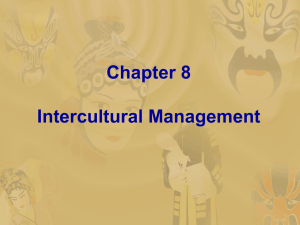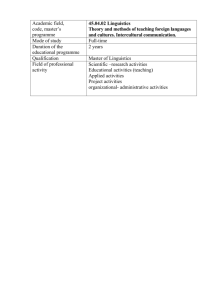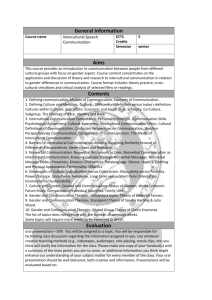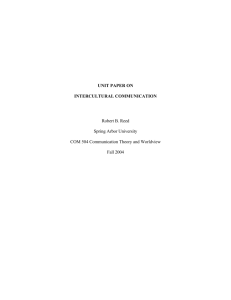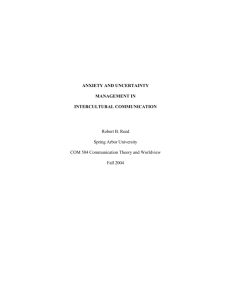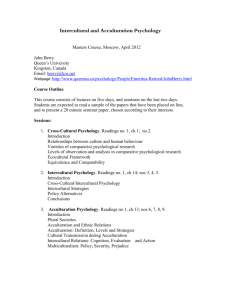Reading Guide for Cooper & Simonds
advertisement
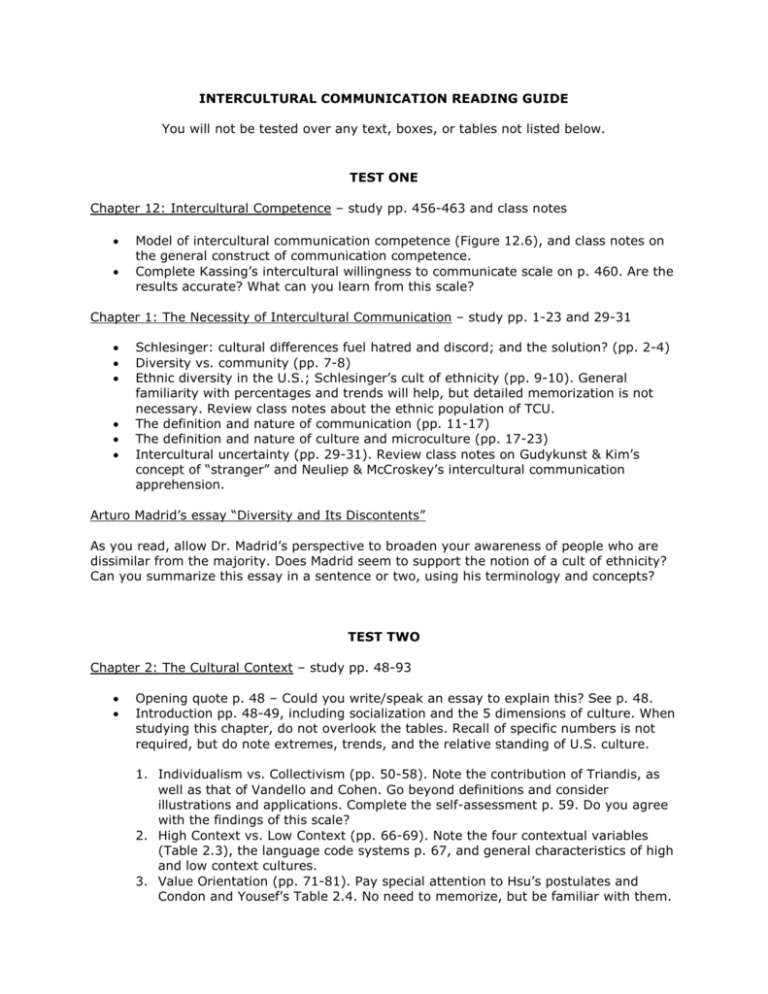
INTERCULTURAL COMMUNICATION READING GUIDE You will not be tested over any text, boxes, or tables not listed below. TEST ONE Chapter 12: Intercultural Competence – study pp. 456-463 and class notes Model of intercultural communication competence (Figure 12.6), and class notes on the general construct of communication competence. Complete Kassing’s intercultural willingness to communicate scale on p. 460. Are the results accurate? What can you learn from this scale? Chapter 1: The Necessity of Intercultural Communication – study pp. 1-23 and 29-31 Schlesinger: cultural differences fuel hatred and discord; and the solution? (pp. 2-4) Diversity vs. community (pp. 7-8) Ethnic diversity in the U.S.; Schlesinger’s cult of ethnicity (pp. 9-10). General familiarity with percentages and trends will help, but detailed memorization is not necessary. Review class notes about the ethnic population of TCU. The definition and nature of communication (pp. 11-17) The definition and nature of culture and microculture (pp. 17-23) Intercultural uncertainty (pp. 29-31). Review class notes on Gudykunst & Kim’s concept of “stranger” and Neuliep & McCroskey’s intercultural communication apprehension. Arturo Madrid’s essay “Diversity and Its Discontents” As you read, allow Dr. Madrid’s perspective to broaden your awareness of people who are dissimilar from the majority. Does Madrid seem to support the notion of a cult of ethnicity? Can you summarize this essay in a sentence or two, using his terminology and concepts? TEST TWO Chapter 2: The Cultural Context – study pp. 48-93 Opening quote p. 48 – Could you write/speak an essay to explain this? See p. 48. Introduction pp. 48-49, including socialization and the 5 dimensions of culture. When studying this chapter, do not overlook the tables. Recall of specific numbers is not required, but do note extremes, trends, and the relative standing of U.S. culture. 1. Individualism vs. Collectivism (pp. 50-58). Note the contribution of Triandis, as well as that of Vandello and Cohen. Go beyond definitions and consider illustrations and applications. Complete the self-assessment p. 59. Do you agree with the findings of this scale? 2. High Context vs. Low Context (pp. 66-69). Note the four contextual variables (Table 2.3), the language code systems p. 67, and general characteristics of high and low context cultures. 3. Value Orientation (pp. 71-81). Pay special attention to Hsu’s postulates and Condon and Yousef’s Table 2.4. No need to memorize, but be familiar with them. 4. Power Distance (pp. 81-88). Note the general characteristics of high and low power distance cultures, especially how power is acquired in different cultures and the role of face communication and power. Note contributions of Hofstede and Ting-Toomey. 5. Uncertainty Avoidance (pp. 90-92), including how cultures use different communication strategies to reduce uncertainty. Try not to be confused by the complicated semantics: “weak uncertainty avoidance” means “strong uncertainty orientation.” Dawn Braithwaite’s essay “Viewing Persons with Disabilities as a Culture.” Pay special attention to the 4 dimensions of the concept of “redefinition.” TEST THREE Chapter 6: The Socio-Relational Context (only the portions of the chapter noted below) Sex and gender groups (pp. 231-234); note Hofstede’s masculinity index (Table 6.1) Sex and gender roles across cultures, only as examples (pp. 234-239) Chapter 7: The Verbal Code: Human Language (only the portions noted below) The Sapir-Whorf hypothesis (pp. 247-248). Note both terminology and significance. Bernstein’s elaborated and restricted codes (pp. 258). Be able to provide examples as well as definitions. Gudykunst and Ting-Toomey’s taxonomy of cross-cultural communication styles (pp. 259-266). Examples and definitions. Language and ethnic identity (pp. 269-274). Also read about Hispanic-American language issues (pp. 106-108) and African-American language (pp. 110-114.) Chapter 4: The Environmental Context (only the portions of the chapter noted below) Privacy (pp. 153-162). Complete the self-assessment pp. 155-156, and be careful with the complicated scoring system. Do you agree with the results? Note Westin’s and Calvert’s theoretical work on privacy. Time orientations (pp. 162-166). Complete the self-assessment pp. 167-168. Do you agree with the results? Julia Wood’s essay “Gendered Interaction: Masculine and Feminine Styles of Verbal Communication.” Study this article in detail. Can you make connections between Dr. Wood’s ideas and content from the textbook? Note the concept of speech communities, characteristics of masculine and feminine styles, and specific illustrations in the article. TEST FOUR Review class notes on nonverbal communication (see Ch. 8 if needed) Chapter 5: The Perceptual Context (only the portions of the chapter noted below) Positive/negative views of stereotyping (pp. 188-191) American stereotypes (pp. 188-197 and 201-203), including the two “Student Voices” pages --Compare prejudice with stereotyping. --Out-group homogeneity effect, illusory correlation principle, self-fulfilling prophecy, and stereotype threats Positive/negative views of ethnocentrism (pp. 205-209) --Pay special attention to Lukens’ and Peng’s work on how people use language to distance themselves from out-groups. Note the terminology and think of examples you have observed. --Does racism differ from ethnocentrism? --The author’s explanations for how racism develops: fear, economics, and the frustration-aggression hypothesis Chapter 3: The Microcultural Context (only the pages below) Hispanics/Latinos (pp. 104-109), including Table 3.2 and class notes. African Americans (pp. 109-114), including discussion of Ebonics. Review class notes. Asian Americans (pp. 114-116 and summary Table 3.4). Elisa Martinez’s essay “Having the Choice of Who to Be” Martin and Hicks’ article “Black and Male in America” Simmons et al.’s article “Understanding the African-American Student Experience” The Great Debaters and Arranged -- Make two statements or observations about each of these movies that illustrate specific concepts or theories we have studied in the course. Use course-related terminology. TEST FIVE Chapter 12: Acculturation and Culture Shock (only the pages listed below) The acculturation process (pp. 436-441), including the modes of acculturation in Figure 12.1. Acculturation in the United States (pp. 441-445). If you are Mexican-American or African-American, complete the appropriate acculturation scale in this chapter. Culture shock (pp. 447-453), especially Figures 12.3 and 12.4, and specific strategies for managing culture shock. Chapter 9: Developing Intercultural Relationships (only the pages listed below) Perceptions of intimacy (pp. 347-351), including East-West contrasts and Table 9.1 Marital relationships (pp. 351-352). In pp. 359-368 pay special attention to the role of communication in interracial marriages, general findings of research into mate selection, arranged marriages, and divorce across cultures. Review class notes on Romano’s four models of intercultural marriage.

